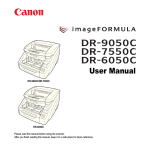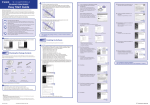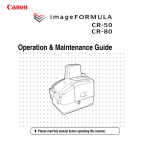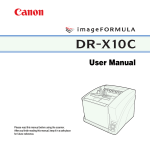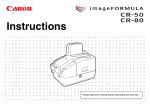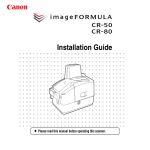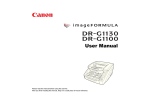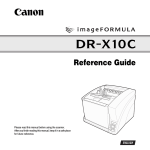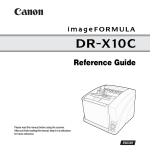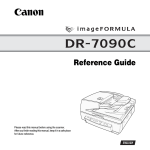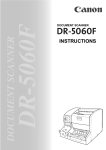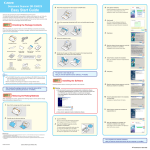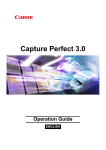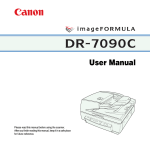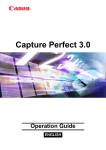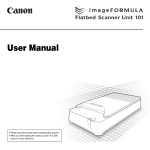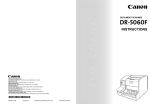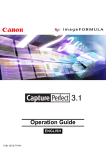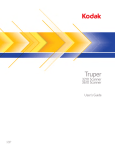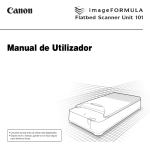Download Canon DR-6050C Owner's Manual
Transcript
Reference Guide DR-9050C/DR-7550C DR-6050C Please read this manual before using the scanner. After you finish reading this manual, keep it in a safe place for future reference. READ CAREFULLY BEFORE OPENING THE SEALED DISK PACKAGE CANON SOFTWARE LICENSE AGREEMENT IMPORTANT-READ THIS AGREEMENT BEFORE OPENING THE SEALED DISK PACKAGE! BY OPENING THE SEALED DISK PACKAGE, YOU ARE DEEMED TO AGREE TO BE BOUND BY THIS AGREEMENT. This legal document is a license agreement between you and Canon Electronics Inc. (“Canon”). BY OPENING THE SEALED DISK PACKAGE, YOU ARE DEEMED TO AGREE TO BE BOUND BY THE TERMS OF THIS AGREEMENT. IF YOU DO NOT AGREE TO THE TERMS OF THIS AGREEMENT, DO NOT OPEN THE SEALED DISK PACKAGE AND PROMPTLY RETURN THE CANON SCANNER, THE DISK PACKAGE CONTAINING SCANNER DRIVER SOFTWARE PROGRAMS AND/OR SCANNER UTILITY SOFTWARE PROGRAM PROPRIETARY TO CANON OR ITS LICENSOR (THE “SOFTWARE”) AND THE ACCOMPANYING DOCUMENTATION AND OTHER ITEMS TO THE PLACE WHERE YOU OBTAINED THEM FOR A REFUND BEFORE THEY ARE USED OR OPENED OR UNPACKED. In consideration of the right to use the SOFTWARE, you agree to abide by the terms and conditions of this Agreement. 1. GRANT OF LICENSE: Canon grants you the personal, nonexclusive right to use the SOFTWARE only on a single computer. You shall need to obtain multiple licenses separately from Canon when you shall install the SOFTWARE on multiple computers. You shall not assign, sublicense, sell, rent, lease, loan, convey or transfer to any third party, or send or bring the SOFTWARE out of the country where you originally obtain it to other countries without required authorization of applicable governments, or copy, duplicate, translate or convert to another programming language the SOFTWARE or accompanying documentation, except as expressly provided herein. i Except as expressly permitted under the applicable law, you shall not alter, modify, disassemble, decompile or otherwise reverse engineer the SOFTWARE or accompanying documentation and you also shall not have any third party do so. 2. BACK-UP COPY: You may make one copy of the SOFTWARE solely for a back-up purpose or copy the SOFTWARE onto the permanent storage device (e.g. a hard disk) of your computer and retain the original for a back-up purpose. Except as expressly permitted under the applicable law, any other copying of the SOFTWARE is a violation of this Agreement. You must reproduce and include the copyright notice on the back-up copy. 3. SUPPORT AND UPDATE: Canon, Canon’s affiliate, their distributor or dealer is not responsible for maintaining or helping you to use the SOFTWARE. No updates, fixes or support will be made available for the SOFTWARE. 4. LIMITED WARRANTY AND DISCLAIMER OF INDEMNITY: Canon, Canon’s affiliate, their distributor or dealer will not guarantee uninterrupted service, or absence or correction of errors. Therefore, the SOFTWARE is licensed on an “AS IS” basis without warranty of any kind. The diskette on which the SOFTWARE is recorded is warranted against defective material or workmanship under normal use for a period of ninety (90) days from the date you purchased the same as evidenced by a receipt or otherwise. The limited warranty does not apply if the failure of the diskette resulted from accident, abuse or misapplication of the SOFTWARE and shall not extend to anyone other than the original user of the SOFTWARE. CANON, CANON’S AFFILIATE, THEIR DISTRIBUTOR OR DEALER DISCLAIMS ALL IMPLIED WARRANTIES, INCLUDING ANY WARRANTY OF MERCHANTABILITY OR FITNESS FOR A PARTICULAR PURPOSE, WITH RESPECT TO THE SOFTWARE OR ACCOMPANYING DOCUMENTATION. CANON, CANON’S AFFILIATE, THEIR DISTRIBUTOR OR DEALER SHALL HAVE NO OBLIGATION TO INDEMNIFY YOU AGAINST ANY CLAIM OR SUIT BROUGHT BY A THIRD PARTY ALLEGING THAT THE SOFTWARE, ACCOMPANYING DOCUMENTATION OR THE USE THEREOF INFRINGES ANY INTELLECTUAL PROPERTY OF SUCH THIRD PARTY. 8. ACKNOWLEDGEMENT: BY OPENING THE SEALED DISK PACKAGE, YOU ACKNOWLEDGE THAT YOU HAVE READ THIS AGREEMENT, UNDERSTOOD IT, AND AGREE TO BE BOUND BY ITS TERMS AND CONDITIONS. YOU ALSO AGREE THAT THIS AGREEMENT IS THE COMPLETE AND EXCLUSIVE STATEMENT OF AGREEMENT BETWEEN YOU AND CANON CONCERNING THE SUBJECT MATTER HEREOF AND SUPERSEDES ALL PROPOSALS OR PRIOR AGREEMENTS, VERBAL OR WRITTEN, AND ANY OTHER COMMUNICATIONS BETWEEN YOU AND CANON RELATING TO THE SUBJECT MATTER HEREOF. NO AMENDMENT TO THIS AGREEMENT SHALL BE EFFECTIVE UNLESS SIGNED BY A DULY AUTHORIZED REPRESENTATIVE OF CANON. THE ABOVE IS CANON’S ENTIRE LIABILITY AND YOUR EXCLUSIVE REMEDY IN CONNECTION WITH THE SOFTWARE AND ACCOMPANYING DOCUMENTATION. Should you have any questions concerning this Agreement, or if you desire to contact Canon for any reason, please write to Canon’s local affiliate. NEITHER CANON, CANON’S AFFILIATE, THEIR DISTRIBUTOR NOR DEALER IS LIABLE FOR ANY LOSS OR DAMAGE INCLUDING CONSEQUENTIAL OR INCIDENTAL LOSS OR DAMAGE SUCH AS LOSS OF PROFITS, EXPENSE OR INCONVENIENCE, WHATSOEVER CAUSED BY OR ARISING OUT OF THE SOFTWARE, ACCOMPANYING DOCUMENTATION OR THE USE THEREOF. 5. TERM: This Agreement is effective upon opening the sealed disk package and remains in effect until terminated. You may terminate this Agreement by destroying the SOFTWARE and any copy thereof. This Agreement will also terminate if you fail to comply with any of the terms of this Agreement. In addition to Canon enforcing its respective legal rights, you must then promptly destroy the SOFTWARE and any copy thereof. 6. U.S. GOVERNMENT RESTRICTED RIGHTS NOTICE: The SOFTWARE is provided with RESTRICTED RIGHTS. Use, duplication or disclosure is subject to restrictions as set forth in either subparagraph (c) (1) (ii) of the Rights in Technical Data and Computer Software clause at DFARs 252.227-7013 or subparagraph (c) (1) and (2) of the Commercial Computer Software Restricted Rights Clause at FAR 52.227-19, as applicable. 7. SEVERABILITY: In the event that provision of this Agreement is declared or found to be illegal by any court or tribunal of competent jurisdiction, such provision shall be null and void with respect to the jurisdiction of that court or tribunal and all the remaining provisions of this Agreement shall remain in full force and effect. ii FCC REGULATIONS (For 120 V model) Document Scanner: – DR-6050C: Model M11070 – DR-7550C: Model M11069 – DR-9050C: Model M11068 This device complies with Part 15 of the FCC Rules. Operation is subject to the following two conditions: (1) This device may not cause harmful interference, and (2) this device must accept any interference received, including interference that may cause undesired operation. Note: This equipment has been tested and found to comply with the limits for a Class B digital device, pursuant to Part 15 of the FCC Rules. These limits are designed to provide reasonable protection against harmful interference in a residential installation. This equipment generates, uses, and can radiate radio frequency energy and, if not installed and used in accordance with the instructions, may cause harmful interference to radio communications. However, there is no guarantee that interference will not occur in a particular installation. If this equipment does cause harmful interference to radio or television reception, which can be determined by turning the equipment off and on, the user is encouraged to try to correct the interference by one or more of the following measures: – Reorient or relocate the receiving antenna. – Increase the separation between the equipment and receiver. – Connect the equipment into an outlet on a circuit different from that to which the receiver is connected. – Consult the dealer or an experienced radio/TV technician for help. Use of shielded cable is required to comply with class B limits in Subpart B of Part 15 of FCC Rules. Do not make any changes or modifications to the equipment unless otherwise specified in the manual. If such changes or modifications should be made, you could be required to stop operation of the equipment. Canon U.S.A. Inc. One Canon Plaza, Lake Success NY 11042, U.S.A. Tel. No. (516)328-5000 iii RADIO INTERFERENCE REGULATIONS (For 120 V models) This digital apparatus does not exceed the Class B limits for radio noise emissions from digital apparatus as set out in the Interference-causing equipment standard entitled “Digital Apparatus”, ICES-003 of the Industry Canada. RÈGLEMENT SUR LE BROUILLAGE RADIOÉLECTRIQUE (For 120 V models) Cet appareil numérique respecte les limites de bruits radioélectriques applicables aux appareils numériques de Classe B prescrites dans la norme sur le matériel brouilleur: “Appareils Numériques”, NMB-003 édictée par l’Industrie Canada. International ENERGY STAR® Office Equipment Program As an ENERGY STAR® Partner, Canon Electronics Inc. has determined that this machine meets the ENERGY STAR® Program guidelines for energy efficiency. The International ENERGY STAR® Office Equipment Program is an international program that promotes energy saving through the use of computers and other office equipment. The program backs the development and dissemination of products with functions that effectively reduce energy consumption. It is an open system in which business proprietors can participate voluntarily. The targeted products are office equipment, such as computers, displays, printers, facsimiles, copiers, and scanners. The standards and logos are uniform among participating nations. European Union (and EEA) only. This symbol indicates that this product is not to be disposed of with your household waste, according to the WEEE Directive (2002/96/EC) and your national law. This product should be handed over to a designated collection point, e.g., on an authorized one-for-one basis when you buy a new similar product or to an authorized collection site for recycling waste electrical and electronic equipment (EEE). Improper handling of this type of waste could have a possible negative impact on the environment and human health due to potentially hazardous substances that are generally associated with EEE. At the same time, your cooperation in the correct disposal of this product will contribute to the effective usage of natural resources. For more information about where you can drop off your waste equipment for recycling, please contact your local city office, waste authority, approved WEEE scheme or your household waste disposal service. For more information regarding return and recycling of WEEE products, please visit www.canon-europe.com/environment. (EEA: Norway, Iceland and Liechtenstein) Für EMVG Dieses Produkt ist zum Gebrauch im Wohnbereich, Geschäfts-und Gewerbebereich sowie in Kleinbetrieben vorgesehen. Für 3. GPSGV “Maschinenlärminformations-Verordnung 3. GPSGV: Der höchste Schalldruckpegel beträgt 70 dB(A) oder weniger gemäß EN ISO 7779” Model Names The following names may be provided for the safety regulations in each sales region of the Document Scanner. DR-6050C: Model M11070 DR-7550C: Model M11069 DR-9050C: Model M11068 Trademarks • Canon and the Canon logo are registered trademarks of Canon Inc. in the United States and may also be trademarks or registered trademarks in other countries. • imageFORMULA is a trademark of Canon Electronics Inc. • Microsoft and Windows are either registered trademarks or trademarks of Microsoft Corporation in the United States and other countries. • Adobe, Acrobat, and Adobe Reader are registered trademarks or trademarks of Adobe Systems Incorporated in the United States and other countries. • ISISTM is a trademark of EMC Corporation in the United States. • Other product and company names herein are, or may be, the trademarks of their respective owners. Copyright Copyright 2009 by Canon Electronics Inc. All rights reserved. No part of this publication may be reproduced or transmitted in any form or by any means, electronic or mechanical, including photocopying and recording, or by any information storage or retrieval system without the prior written permission of Canon Electronics Inc. Disclaimers The information in this document is subject to change without notice. CANON ELECTRONICS INC. MAKES NO WARRANTY OF ANY KIND WITH REGARD TO THIS MATERIAL, EITHER EXPRESS OR IMPLIED, EXPECT AS PROVIDED HERE IN, INCLUDING WITHOUT LIMITATION, THEREOF, WARRANTIES AS TO MARKETABILITY, MERCHANTABILITY, FITNESS FOR A PARTICULAR PURPOSE OF USE OR NONINFRINGEMENT. CANON ELECTRONICS INC. SHALL NOT BE LIABLE FOR ANY DIRECT, INCIDENTAL, OR CONSEQUENTIAL DAMAGES OF ANY NATURE, OR LOSSES OR EXPENSES RESULTING FROM THE USE OF THIS MATERIAL. iv Preface Thank you for purchasing the Canon imageFORMULA DR-6050C/DR-7550C/DR-9050C Document Scanner. Please read this and the following manuals thoroughly before using the scanner to become acquainted with its capabilities and make the most of its many functions. After reading the manuals, store them in a safe place for future reference. Manuals for the Scanner The documentation for the scanner consists of the Easy Start Guide and the Reference Guide (this manual) (supplied with the scanner), the User Manual, and the CapturePerfect3.0 Operation Guide, which are provided in electronic form and registered in the menu during software installation. Hint • The User Manual and the CapturePerfect 3.0 document files are installed in the following locations during software installation. User Manual Easy Start Guide This manual describes the procedures for setting up the scanner for use. Please follow the procedures in the Easy Start Guide to set up the scanner. CapturePerfect 3.0 Operation Guide Reference Guide (This Manual) This manual consists of the basic scanner operating instructions extracted from the User Manual. User Manual (Electronic Manual) This manual consists of two sections: Hardware and Software. The Hardware section provides general information about the scanner operational settings, maintenance, and troubleshooting. The Software section describes how to use the ISIS/ TWAIN driver with the scanner, and how to set up job registration tools. CapturePerfect 3.0 Operation Guide (Electronic Manual) This is the operation guide for CapturePerfect 3.0, the Canon document scanner application program. v • Electronic versions of all manuals are available for viewing from the Setup CD. Symbols Used in This Manual How This Manual is Organized The following symbols are used in this manual to explain procedures, restrictions, handling precautions, and instructions that should be observed for safety. This manual consists of the following chapters. WARNING Indicates a warning concerning operations that may lead to death or injury to persons if not performed correctly. To use the scanner safely, always pay attention to these warnings. CAUTION Indicates a caution concerning operations that may lead to injury to persons, or damage to property if not performed correctly. To use the scanner safely, always pay attention to these cautions. Chapter 1 Before You Start Using the Scanner Provides an overview of the scanner Chapter 2 Basic Operation Describes the basic uses of the scanner Chapter 3 Maintenance Describes routine cleaning and roller replacement Chapter 4 Practical Examples Describes displayed messages and troubleshooting solutions Chapter 5 Appendix Provides a list of specifications and support information IMPORTANT Indicates operational requirements and restrictions. Make sure that you read these items carefully to operate the scanner correctly, and avoid damage to the scanner. Hint Indicates a clarification of an operation, or contains additional explanations for a procedure. Reading these notes is highly recommended. vi Table of Contents Preface.................................................................... v Manuals for the Scanner ..........................................v Symbols Used in This Manual ................................. vi How This Manual is Organized................................ vi Chapter 1 Before You Start Using the Scanner 1. Important Safety Instructions .............................. 2 Installation Location................................................. 2 Power ...................................................................... 2 Moving the Scanner................................................. 3 Handling .................................................................. 3 Disposal................................................................... 5 2. Features .............................................................. 6 3. Names and Functions of Parts .......................... 10 Front View, Feeder Inlet, and Eject Outlet............. 10 Rear View .............................................................. 11 Control Panel......................................................... 12 Chapter 2 Basic Operation 1. Turning the Power ON and OFF ....................... 14 1. Regular Maintenance........................................ 36 Cleaning the Scanner ............................................ 36 Cleaning the Sensors ............................................ 36 Cleaning the Scanning Glass and Rollers ............. 37 Power Outlet.......................................................... 38 2. Replacing the Transport Rollers ....................... 39 Roller Replacement Cycle ..................................... 39 Checking and Resetting the Page Counter ........... 39 Removing and Reinstalling the Rollers.................. 41 Chapter 4 Practical Examples 1. Messages.......................................................... 48 Status Display........................................................ 48 Error Messages ..................................................... 49 2. Troubleshooting ................................................ 51 Trouble Categories ................................................ 51 Problem and Solution ............................................ 51 Chapter 5 Appendix 1. Specifications.................................................... 56 2. Documents ........................................................ 15 Unit Specifications ................................................. 56 Consumables......................................................... 57 External Dimensions.............................................. 58 Acceptable Documents.......................................... 15 2. Index ................................................................. 59 About the Power Switch ........................................ 14 3. Document Feed and Eject Trays....................... 18 Preparing the Document Feed Tray ...................... 18 Adjusting the Document Guides ............................ 20 Preparing the Document Eject Tray ...................... 22 4. Document Feeding Methods ............................. 23 Selecting the Document Feeding Method ............. 23 5. Scanning ........................................................... 26 About the Job Function.......................................... 26 CapturePerfect 3.0 ................................................ 27 6. Clearing a Paper Jam or Double Feed Error..... 32 Paper Jam Handling .............................................. 32 Handling a Double Feed........................................ 33 vii Chapter 3 Maintenance Chapter 1 Before You Start Using the Scanner 1. Important Safety Instructions .............................. 2 Installation Location .................................................2 Power .......................................................................2 Moving the Scanner .................................................3 Handling ...................................................................3 Disposal ...................................................................5 2. Features.............................................................. 6 3. Names and Functions of Parts.......................... 10 Front View, Feeder Inlet, and Eject Outlet .............10 Rear View...............................................................11 Control Panel .........................................................12 1. Important Safety Instructions To ensure the safe operation of this scanner, be sure to read the safety warnings and precautions described below. Installation Location The performance of this scanner is affected by the environment in which it is installed. Make sure that the location where the scanner is installed meets the following environmental requirements. ● Provide adequate space around the scanner for operation, maintenance, and ventilation. 32.20" (818 mm) or more 24.84" (631 mm) or more 3.9" (100 mm) or more ● Avoid installing the machine in direct sunlight. If this is unavoidable, use curtains to shade the scanner. ● Avoid locations where a considerable amount of dust accumulates. ● Avoid warm or humid locations, such as in the vicinity of a water faucet, water heater, or humidifier, and avoid locations where the fumes from ammonia, paint thinner, or other volatile chemicals may be present. 2 ● Avoid locations that are subject to vibration. ● Avoid exposing the scanner to rapid changes in temperature. If the room in which the scanner is installed is cold but rapidly heated, water droplets (condensation) may form inside the scanner. This may result in a noticeable degradation in scanning quality. The following conditions are recommended for optimal scanning quality: Room temperature: 10 °C to 32.5 °C (50 °F to 90.5 °F) Humidity: 20% to 80% RH ● Avoid installing the scanner near equipment that generates a magnetic field (e.g. speakers, televisions, or radios). Power ● Connect only to a power outlet of the rated voltage and power supply frequency (either 120 V, 60 Hz or 220-240 V, 50/60 Hz, depending on your region). ● Do not use the scanner with a power supply that is not rated for the specified voltage. Doing so might cause fire or electric shock. ● Do not connect other electrical equipment to the same power outlet to which the scanner is connected. Also, when using an extension cord, make sure that the extension cord is rated for the current requirements of the scanner. ● The power cord may become damaged if it is often stepped on or if heavy objects are placed on it. Continued use of a damaged power cord can lead to an accident, such as a fire or electrical shock. Moving the Scanner ● The scanner weights about 50 lbs (22.5 kg). To lift or move the scanner, always use two people, one on each side. Never attempt to lift the scanner by yourself. You could drop the scanner or pinch your fingers, resulting in personal injury or damage to the scanner. Remember to be extra careful when moving it. ● Make sure to disconnect the interface cable and power cord when moving the scanner. If the scanner is carried with these items connected, the plugs and connectors may be damaged or cause the scanner to fall and result in personal injury or damage to the scanner. Handling WARNING Note the following precautions whenever using the scanner. Failure to do so may result in a fire or electric shock. ■ Never use alcohol, benzene, paint thinner, aerosol sprays, or any other highly flammable substance near the scanner. ■ Do not cut, damage, or modify the power cord. Do not place heavy objects on the power cord, and do not pull or excessively bend the power cord. ■ Never connect the power cord when your hands are wet. ■ Do not connect the scanner to a multiplug power strip. ■ Do not knot or coil the power cord, as this may result in a fire or electric shock. When connecting the power cord, make sure that the power plug is securely and completely inserted into the power outlet. ■ To use a reel-type extension cord, unwind all of the cord from the reel. Long-term operation with the cord wound on the reel may cause the cord to overheat and could cause a fire. ■ Do not use power cords other than the power cord provided with this scanner. 3 1 Before You Start Using the Scanner ● Do not use the power cord while it is coiled. ● Do not pull directly on the power cord. When disconnecting the power cord, grasp the plug and remove it from the outlet. ● Keep the area around the power plug clear of objects so that the power cord can be disconnected easily in an emergency. ● If you have any questions regarding the power supply, contact your local authorized Canon dealer or service representative for further information. ■ Never try to take the scanner apart or modify it in any way, as this is dangerous and may lead to a fire or electric shock. ■ Do not use flammable aerosol sprays products near the scanner. ■ When cleaning the scanner, turn the power switch OFF and disconnect the power plug from the power supply. ■ Clean the scanner using a slightly dampened cloth which has been well wrung out. Never use alcohol, benzene, paint thinner, or any other flammable substances. ■ If the scanner makes strange noises, or gives off smoke, heat, or strange odors, or the scanner does not function or other abnormalities occur when you use the scanner, immediately turn the power switch OFF, and disconnect the power plug from the power outlet. Then, contact your local authorized Canon dealer or service representative for further information. ■ Do not drop the scanner, or subject it to impact or strong shock. Should the scanner ever become damaged, immediately turn the power switch OFF, and disconnect the power plug from the power outlet. Then, contact your local authorized Canon dealer or service representative to have the unit serviced. ■ Before moving the scanner, make sure to turn the power switch OFF, and disconnect the power plug from the power outlet. CAUTION ■ Do not install the scanner on a surface that is unstable or tilted, or in an area subject to excessive vibrations, as this may cause the scanner to fall, resulting in personal injury or damage to the scanner. 4 ■ Do not block the ventilation openings. Doing so could case the scanner to overheat, creating a risk of fire. ■ Never place small metal objects such as staples, paper clips, or jewelry on the scanner. These items may fall into the scanner, and cause a fire or electric shock. Should such objects ever fall inside the scanner, immediately turn the power switch OFF, and disconnect the power plug from the power outlet. Then, contact your local authorized Canon dealer or service representative to have the unit serviced. ■ Do not locate the scanner in a humid or dusty location. Doing so may cause a fire or electric shock. ■ Do not place objects on top of the scanner. Such objects may tip or fall over, resulting in personal injury. ■ When unplugging the power cord, grasp it firmly by its plug. Do not pull directly on the power cord, as this may damage or expose the cord’s internal wiring, resulting in a fire or electric shock. ■ Leave sufficient space around the power plug so that it can be unplugged easily. If objects are placed around the power plug, you will be unable to unplug it in an emergency. ■ Do not allow water or flammable substances (alcohol, paint thinner, benzene, etc.) to spill into the scanner, as this may result in a fire or electric shock. ■ Turn OFF the power switch for safety when not using the scanner for a long period of time, such as overnight. Also, turn OFF the power switch, and disconnect the power cord from the power outlet for safety when the machine will not be used for an extended period of time, such as during consecutive holidays. ■ Do not wear loose clothing or jewelry that may get caught in the scanner while you are using it. This may result in personal injury. Be extra careful of neckties and long hair. If anything becomes caught in the scanner, immediately disconnect the power cord to stop the scanner. ■ Be careful when placing paper in the scanner and when removing jammed paper. It is possible to cut your hand on the edge of a sheet of paper. 1 Before You Start Using the Scanner Disposal ● When disposing of this scanner, make sure to follow all local ordinances and laws or consult with the retailer who sold you the scanner. 5 2. Features The main features of the DR-6050C/7550C/9050C are described below. Scanner Features ● Variety of Scanning Modes The scanner is equipped with six scanning modes: Black and White, Error Diffusion, Advanced Text Enhancement, Advanced Text Enhancement II, 256Color Grayscale, and 24-Bit Color. * Advanced Text Enhancement can clarify scanned text by processing background or foreground colors. ● Fast Document Feeding The scanner can scan up to 90 document sheets per minute of LTR/A4-size paper in black and white, grayscale, and color scanning modes. (For the DR9050C) * Scanning conditions: LTR/A4 portrait, duplex, 200 dpi ● Large Capacity Feeder Up to 500 plain paper document sheets can be loaded in the document feed tray. (Maximum of 300 sheets for the DR-6050C) ● Count-Only Mode When operating the scanner as a stand-alone device, this mode counts the number of loaded document sheets. ● Adjustable Document Feed Tray The position of the document feed tray can be adjusted up or down according to the number of document sheets to be loaded. (See “Preparing the Document Feed Tray” on p. 18.) 6 ● Long Document Mode Document sheets up to three meters (118.1 inches) long can be scanned. (See “Long Document Mode Setting” on p. 16.) ● Job Function Scanning conditions and the saving destination for image files are registered with the job, so you can scan using only control panel key operations. (See “About the Job Function” on p. 26.) ● Freely Adjustable Document Guides The left and right document guides can be adjusted so that documents can be positioned to scan either the left or right side. (See “Adjusting the Document Guides” on p. 20.) ● User Mode The User Mode functions can be employed to set the scanner for practically any condition. For details on the User Mode settings, refer to the User Manual. Fixed-Size Scanning ● Verify Scan While scanning, the count of document pages scanned is verified against a pre-specified count or the count obtained from Count-Only Mode. ● Text Orientation Detection The text orientation on each page is detected, and the scanned image is rotated in 90-degree increments as necessary for normalization. Auto-Size Detection Scanning ● Skew Detection The scanner stops feeding when a skewed document is detected as it touches the edge of the feeder inlet. ● Staple Detection The scanner stops feeding when it detects the presence of stapled documents. ● Ultrasonic Double-Feed Detection The scanner stops feeding when the ultrasonic sensor detects that two or more document pages are feeding at the same time. * A non-detection zone can be specified to avoid doublefeed detection in areas such as those containing adhesive labels. ● Double-Feed Detection by Document Length The scanner stops feeding when a double feed is detected by comparing document lengths. Feeding Direction The text orientation is detected and the image is rotated Image Processing ● Prevent Bleed Through/Remove Background Prevents the background or original image on the reverse side of thin originals from appearing in scanned images. ● Image Rotation The scanner can rotate scanned images in 90° increments, or detect the text orientation and rotate the image in 90° increments to correct its orientation. ● Deskew The scanner straightens an image when it recognizes from the image that the document page was fed askew. * Using the length of the first document page as a reference, the scanner detects a double feed when a page of a different length is fed. ● Prescan At the start of scanning, this function prescans the first page of a document and pauses so that you can use the first image to adjust the brightness and contrast before resuming scanning. Skewed Image Deskewed Image 7 1 Before You Start Using the Scanner Detection Functions ● Auto Image Type Detection The scanner automatically detects whether documents are in black and white or color. ● Auto Paper Size Detection The document page size is detected before scanning. ● Dropout and Color Enhancement The scanner is equipped with drop-out and enhancement functions that enable you to specify one color (red, blue, or green) to be omitted (dropped out) or enhanced when scanning, respectively. ● Folio Scan Documents that are too large to fit in the feeder inlet can be folded and scanned on both sides, and the images combined into a single image. Front and Back Images Color Document Image with Red Drop-Out set (red filtered) ● Remove Binder Holes Erases the shadows that appear on scanned images form binding holes on the original document. Image with Binding Holes Image without Binding Holes ● Skip Blank Page The scanner scans both sides of a document and skips saving the image of any side it determines to be a blank page. ● MultiStream The scanner supports MultiStream, which, depending on the software application, can create two images with different scanning conditions from a single scan pass. However, this function is only available when using CapturePerfect 3.0 (supplied with the scanner) or another application program that supports the MultiStream function. Document to be Scanned Two-Sided Documents with a Blank Side 8 Images with Blank Page Skipped Reconstructed Image * Folio Scan supports up to A1-size (23.4" × 33.1" (594 × 841 mm)) documents when used together with the Long Document Mode. (150 dpi, Color) (300 dpi, Black & White) Two Types of Output Image Other Functions ● Rapid Recovery System When this function is activated and a sensor detects a misfeed due to a paper jam or double feed, which causes feeding to stop, scanning pauses to allow you to correct the cause of the misfeed, after which scanning continues from the document page on which the abnormality was detected. (See “Clearing a Paper Jam or Double Feed Error” on p. 32.) 1 Before You Start Using the Scanner * The Rapid Recovery System is effective when feeding stops as a result of detection of a Paper Jam, Double Feed, Skew, or Staple. Options ● Imprinter (Option) As an option, printing can be made on scanned documents. ● Barcode Detection (Option) Barcodes on documents can be detected by installing the optional barcode module. ● Patchcode Support (Option) By installing the optional patchcode decoder, patch code sheets inserted between document pages can be detected for batch separation. 9 3. Names and Functions of Parts The names and functions of the DR-6050C/7550C/9050C parts are shown below. Front View, Feeder Inlet, and Eject Outlet a Upper Unit Open when cleaning the rollers or paper jams. b Imprinter Cover Open when replacing the ink cartridge in the optional imprinter or when cleaning the imprinter. c Document Eject Tray Scanned documents are output here. d Control Panel (See p. 12.) e Power Switch Turns the scanner ON and OFF. f Document Eject Tray Extension Open the Document Eject Tray Extension when documents look like they are going to fall off of the eject tray. g Eject Paper Stoppers Adjust to fit the length of documents, to avoid document spillage. h Document Guides Adjust to fit the width of documents, so that ejected documents stack neatly. i Document Guides Adjust to fit the width of documents. + Document Guide Lock Lever Locks the Document Guides. , Document Feed Tray Load documents to be scanned here. - Document Feeder Tray Extension / Extension Wire Extend as needed to fit the length of the documents. CAUTION Do not open the imprinter cover if the optional imprinter is not installed. 10 Rear View CAUTION Do not block the ventilation holes. Doing so could cause the scanner to overheat, creating a fire hazard. 11 1 Before You Start Using the Scanner a Ventilation Holes (Exhaust Fan) Exhausts heat from inside the scanner. b Power Connector Connect the supplied power cord here. c USB Connector (Type B) Connect the supplied USB cable here. d SCSI Connector (50-pin half-pitch D-sub receptacle) Connect the SCSI cable here. e DIP Switches (SCSI ID) Selects the scanner’s SCSI ID. Control Panel 12 a Display Panel Displays the user mode, job info, messages, and counter. b Count Clear Key Clears the counter on the display panel. c Enter Key Selects the user mode, and accepts settings. d Keys Selects the user mode and job. e Menu Key Displays the user mode. f Job Key Selects jobs. g Count Only Key Feeds and counts the number of document pages. h Separation Off Key Raises the Document Feed Tray for the non-separating (manual) mode. i New File Key When File Separation by Key is enabled, separates files. + Start Key Starts scanning. , Stop Key Stops the scanning process. Chapter 2 Basic Operation 1. Turning the Power ON and OFF ....................... 14 About the Power Switch .........................................14 2. Documents........................................................ 15 Acceptable Documents ..........................................15 3. Document Feed and Eject Trays ...................... 18 Preparing the Document Feed Tray.......................18 Adjusting the Document Guides.............................20 Preparing the Document Eject Tray .......................22 4. Document Feeding Methods............................. 23 Selecting the Document Feeding Method ..............23 5. Scanning ........................................................... 26 About the Job Function ..........................................26 CapturePerfect 3.0 .................................................27 6. Clearing a Paper Jam or Double Feed Error .... 32 Paper Jam Handling...............................................32 Handling a Double Feed ........................................33 1. Turning the Power ON and OFF Use the power switch to turn the scanner ON and OFF, or if you are using a USB connection, you can set the USB-linked power switch. CAUTION • After turning the scanner OFF, wait at least ten seconds before turning it back ON. • If the scanner is connected via SCSI cable, always turn the scanner ON before turning the computer ON. If you turn the computer ON before the scanner, it may not recognize the scanner properly. About the Power Switch The power switch is located at the lower left side of the front of the scanner. Press the power switch to turn the scanner ON. (See p. 18.) Press the power switch again to turn the scanner OFF. Power Switch Hint In the User Mode, if the tray position is set to a height other than the lowest position, then the Document Feed Tray moves up and down when the power is turned on. In this case, the Document Feed Tray is lowered once to the lowest position and then moves to the configured height. When the power is turned off, the Document Feed Tray does not move and stays at the configured height. (See p. 18.) 14 IMPORTANT • When connecting the scanner to the computer using a SCSI cable, be sure to turn ON the scanner first, and then turn ON the computer. If you turn ON the computer first, the scanner may not be properly recognized by the computer. • After turning the scanner OFF, wait at least 10 seconds before turning it ON again. • If you will not be using the scanner for an extended period, disconnect the power cord from the AC outlet for safety. 2. Documents The scanner can scan documents ranging in size from business cards and checks to 11" × 17"/A3 size. The size and type of paper that can be fed depends on the feeding method. Acceptable Documents The scanner can feed the following document sizes. • Manual feeding requires feeding one document at a time while the [Separation Off] key on the control panel is lit and the Document Feed Tray is raised. Hint When the Long Document Mode is selected, Paper Size Detection can be used for scanning documents up to 118.11" (3 m) long. (See “Long Document Mode Setting” on p. 16.) Paper Thickness Continuous Feeding: 14 to 56 lb bond (52 g/m2 to 209 g/m2) (0.06 mm to 0.25 mm) Manual Feeding: 11 lb to 64 lb bond (42 g/m2 to 255 g/m2) (0.05 mm to 0.30 mm) Hint • Continuous feeding feeds document pages one after another by the feed and retard rollers after placing a batch of documents in the Document Feed Tray. Basic Operation Size Width: 2" to 12.01" (50.8 mm to 305 mm) Length: 2.76" to 17.01" (70 mm to 432 mm) (without using the Long Document Mode) 2.76" to 39.37" (70 mm to 1m) (using [ON1] in the Long Document Mode) 2.76" to 118.11" (70 mm to 3m) (using [ON2] in the Long Document Mode) 2 Separation Off Key IMPORTANT A document must meet the following criteria to be scannable: • When scanning a multipage document, pages must be grouped together so that they have the same size, thickness, and weight. Scanning different types of paper at one time can cause the scanner to jam. • Always make sure that the ink on a document is dry before scanning it. Scanning documents with the ink still wet may soil the rollers or scanning glass, cause lines or smudges to appear on images, or dirty other documents. • Always clean the rollers or scanning glass after scanning a document written in pencil. Scanning documents with pencil written on them may soil the rollers or scanning glass, cause stripes to appear in images, or dirty other documents. • When scanning a two-sided document that is printed on thin paper, the image on the opposite side of each page may show through. Adjust the scanning brightness from the application program, or enable the [Prevent Bleed Through/Remove Background] setting before scanning. 15 • Note that scanning the following types of documents can cause a paper jam or malfunction. To scan such a document, make a photocopy of the document and then scan the photocopy. Wrinkled or creased documents Carbon paper Curled documents Coated paper Torn documents Extremely thin, translucent paper Small Size Limitation Mark: When placing documents that are smaller than LTR/A4 size. Large Size Limitation Mark: When placing documents that are larger than LTR/A4 size. ■ Long Document Mode Setting Using the Long Document mode, pages up to 118.11" (3 m) long can be scanned. You can set the Long Document Mode setting from the User Mode. 1. Press the Menu key on the control panel. Documents with paper clips or staples • To scan bound multi-page documents such as invoice booklets, place the bound edge against the feeder inlet and scan by manual feeding. • To use the Long Document Mode, feed document pages manually, one after another. Document Feeder Capacity DR-6050C: Up to 300 sheets of good quality paper or up to 1.10" (28 mm) high (maximum) DR-7550C/9050C: Up to 500 sheets of good quality paper or up to 1.89" (48 mm) high (maximum) Menu Key The User Mode is activated. IMPORTANT Do not exceed the load limitation mark when placing documents in the Document Feed Tray. It may cause paper jams. 2. Press the [ ] key four times to display Long Document Mode. Small Size Limitation Mark Large Size Limitation Mark 16 3. Confirm your settings. 4. Press [Enter]. • When scanning with the Long Document Mode set to [ON2], if the scan is performed at 400/600 dpi or the scan is performed with the scanning mode set to color and the scanning side set to [Duplex], the image may be lost. If this occurs, scan by reducing the resolution, using black and white, or setting the scanning side to [Simplex]. • When scanning using Long Document Mode, [High-Quality Moire Reduction], [Deskew], or document orientation of [90 degrees] or [270 degrees] cannot be used. • If a sheet is loaded at a skewed angle when scanning long documents, it may be damaged by contacting both sides of the transport path. So be careful to avoid loading documents at skewed angles. • Paper jam detection may react slowly when scanning long documents, which could result in jammed documents being damaged. Be especially careful to avoid paper jams. • To feed each document page manually when scanning long documents, press the [Separation Off] key on the control panel. Enter Key The current setting is indicated by blinking square brackets [ ]. Separation Off Key 5. Press the [ ] or [ ] key to select [ON] or [OFF], and press [Enter] to accept the selection. 6. Press the Stop key to exit the User Mode. IMPORTANT • Processing may be slowed when scanning in the Long Document Mode. • When scanning with the Long Document Mode set to [ON1], if the scan is performed with the scanning mode set to color and the image quality set to [Image quality priority], the image may be lost. If this occurs, scan by using black and white or reducing the image quality. 17 2 Basic Operation [ON2]: When the [Auto Detection] or [Scanner’s Maximum] page size setting is selected, document page lengths up to 118.11" (3 m) can be detected. [ON1]: When the [Auto Detection] or [Scanner’s Maximum] page size setting is selected, document page lengths up to 39.37" (1 m) can be detected. [OFF]: When the [Auto Detection] page size setting is selected, document page lengths up to 17.01" (432 mm) can be detected. 3. Document Feed and Eject Trays Before scanning, prepare the Document Feed and Eject Trays for the desired paper size. Preparing the Document Feed Tray 1. Press the Menu key on the control panel. ■ Document Feed Tray The height of the Document Feed Tray can be adjusted according to the number of document pages to be loaded (the default setting is the lowest position). Menu Key The User Mode is activated. Tray Position Setting The height of the Document Feed Tray is set by the Tray Position in the User Mode setting, which minimizes the time required to start feeding by specifying in advance the proper position for the documents to be loaded. 2. Press the [ ] key five times to display Tray Position. 3. Confirm your settings. For the DR-6050C [0]: To load up to 300 sheets [1]: To load up to 100 sheets For the DR-7550C/9050C [0]: To load up to 500 sheets [1]: To load up to 300 sheets [2]: To load up to 100 sheets 18 ■ Document Guides 4. Press [Enter]. Slide the document guides to fit the width of your document. 2 Enter Key The current setting is indicated by blinking square brackets [ ]. 5. Press the [ ] or [ ] key to select [0], [1] or [2]. 6. Press [Enter] to accept the selection. The Document Feed Tray moves to the selected height. ■ Document Feeder Tray Extension / Extension Wire Pull out the tray extension as needed for the length of your document. 7. Press the Stop key to exit the User Mode. 19 Basic Operation Hint The positions of the left and right document guides can also be locked independently for off-center loading. For details, see “Adjusting the Document Guides” (p. 20). Gently open the extension wire. ■ Loading Documents at the Left Side This example shows the procedure for loading documents at the left side of the feeder. 1. Spread the document guides all the way to the left and right. Hint Use the extension wire if the document extends beyond the edge of the document tray. Adjusting the Document Guides 2. Load your documents against the left feed guide. The document guides normally extend at equal distances from the left and right of the center of feeding so that your documents are centered in the feed inlet. However, each document guide has its own lock lever, so you can load documents to the left or right of center by locking the document guides at the appropriate positions. 3. Lock the left document guide (a) by pulling out the lock lever, then slide the right document guide to the right edge of your documents (b). 20 4. Lock the right document guide (a), and unlock the left document guide (b). ■ Resetting the Document Guides To reset the guides so that they are equidistant from the center, perform the following procedure to spread the guides to the left and right as far as they will go. 1. Confirm that the right document guide is locked (a), and slide the left guide all the way to the left (b). 2 Basic Operation 5. Slide the left document guide to the left edge of your documents. 2. Lock the left document guide (a), and unlock the right document guide (b). 3. Slide the right document guide all the way to the right. 21 4. Unlock the left document guide. ■ Document Eject Tray Extension Open the Document Eject Tray Extension when documents look like they are going to fall off of the eject tray. Preparing the Document Eject Tray The Eject Tray includes two Document Eject Guides, the Eject Tray Extension and Eject Paper Stopper, to be adjusted to fit the width and length of your documents. ■ Eject Paper Stoppers Raise the appropriate Eject Paper Stoppers to stop ejected documents from spilling out of the eject tray. ■ Document Guides Slide the document eject guides to fit the width of your documents. The eject position of the document can be checked by feeding a single sheet of the document in Count-Only Mode. For details on the Count-Only mode, refer to the User Manual. Hint The eject paper stoppers are attached to the document eject tray extension, so you can adjust their positions to suit your document length. When an LTR/A4-size paper is loaded, close the document eject tray extension and stand up the upper eject paper stoppers. When an A3-size paper is loaded, open the document eject tray extension and stand up the upper eject paper stoppers. 22 4. Document Feeding Methods Two document feeding methods are available: Continuous Feeding, which feeds documents automatically from the document tray by the pickup roller; and Manual Feeding, which requires one document at a time to be positioned manually for transport by the feed roller, while the pickup roller is disabled. Selecting the Document Feeding Method Continuous Feeding With Continuous Feeding, documents loaded in the Document Feed Tray are picked up automatically by the pickup roller and transported by the feed roller, while the retard roller separates each page to avoid double feeding. Separation Off Key IMPORTANT Pickup Roller Feed Roller Retard Roller • Because pages are not separated by the retard roller during manual feeding, a paper jam will occur if multiple pages are loaded together. • To scan bound multi-page documents such as invoice booklets, place the bound edge against the feed inlet and scan using manual feeding. Hint • The [Separation Off] key is linked to the [Manual Feeding] Feed Option setting of the ISIS/TWAIN driver. • When the [Separation Off] key on the control panel is pressed or the [Manual Feeding] Feed Option is selected, the [Separation Off] key lights and the Document Feed Tray rises. 23 2 Basic Operation Continuous Feeding is the default feeding method, but Manual Feeding can be enabled by selecting Manual Feeding as the Feeding Option for the ISIS/TWAIN driver, or by pressing the Separation Off key on the control panel. A Continuous Manual Feeding Mode is also provided as a way to scan a batch of document pages that cannot be automatically transported. Manual Feeding The Separation Off key lights and the Document Feed Tray rises so that documents can be fed manually one at a time. When manual feeding, you must insert each document page far enough to be pulled in by the feed roller (because the pickup roller is disabled). Continuous Manual Feeding Mode Enable the Continuous Manual Feeding Mode from the User Mode when document pages do not separate well using Continuous Feeding. ■ Continuous Manual Feeding Mode Setting Select Manual Feed Mode in the User Mode settings to enable continuous manual feeding. 1. Press the Menu key on the control panel. Feed Roller Menu Key Retard Roller IMPORTANT When the Continuous Manual Feeding Mode is set to ON from the User Mode, make sure to disable it (set to OFF) when finished scanning. Otherwise, normal continuous feeding will be disabled the next time someone uses the scanner. The User Mode is activated. Hint For Manual Feeding, you must feed document one page at a time. For Continuous Manual Feeding, you must place the documents on the Document Feed Tray and insert them into the Document Feed Tray opening one page at a time, making operation easier. 2. Press the [ ] key five times to display “Manual Feed Mode”. 3. Confirm your settings. [ON]: Disables the pickup roller so that loaded documents have to be hand fed to the feed roller one page at a time. [OFF]: Documents are fed continuously by the pickup roller, except when the Separation Off key is lit. 24 4. Press [Enter]. 2 Enter Key Basic Operation The current setting is indicated by blinking square brackets [ ]. 5. Press the [ ] or [ ] key to select [ON] or [OFF], and press [Enter] to accept the selection. 6. Press the Stop key to exit the User Mode. 25 5. Scanning Scanning operations can be controlled by a scanning application program such as the CapturePerfect 3.0 software included with the scanner, or directly from the control panel of the DR-6050C/7550C/9050C, using the Job Function. This section describes the Job Function and provides an overview of CapturePerfect 3.0. Registered jobs are displayed. About the Job Function The Job Function enables you to use the Job Registration Tool to register different jobs which can then be selected for scanning by pressing the [Job] key on the control panel. Job registration stores scanning condition settings, image file format selection, save destination, and image data processing settings for each job to be used with the Job Function. Hint The Job Registration Tool is a TWAIN-compliant application that is installed along with the ISIS/TWAIN driver. For details, refer to Chapter 9 "Job Registration Tool Settings" in the User Manual. Hint If no job is displayed, you must register a job using the Job Registration Tool. 2. Press the [ ] or [ ] key to select a job. 3. Execute the displayed job by pressing the Start key. ■ Executing Jobs Use the following procedure to execute jobs that have been registered by the Job Registration Tool. 1. Press the Job key on the control panel. Start Key Job Key 4. Open the folder specified during job registration to confirm that the image files have been created. 26 CapturePerfect 3.0 CapturePerfect 3.0 is an ISIS-compatible application developed for Canon document scanners. CapturePerfect 3.0 includes the following modes. Select the desired scan mode from the Scan menu to perform scanning. For more information on CapturePerfect 3.0, refer to the CapturePerfect 3.0 Operation Guide. ■ Scanning with CapturePerfect The following three scanning methods are available from the CapturePerfect Scan menu. Scan Batch to Printer Prints scanned images on a specified printer Scan Batch to Mail Starts your e-mail program and attaches the scanned image to a new e-mail message Scan Batch to File Documents are scanned with the preset scanning conditions, and the scanned image data is saved to a specified folder. Scan Batch to Printer Documents are scanned with the preset scanning conditions, and the scanned image data is printed on a specified printer. Scan Batch to Mail Scanning is performed with the specified scanning conditions, and a MAPI-compliant e-mail client is started to generate a new e-mail message with the scanned images as attachments. Scan Page Only one page of the document is scanned. 27 2 Basic Operation (Network) Scan Batch to File Saves scanned images as files in a specified folder Scan Job The scanning conditions and scan mode (Scan Batch to File, Scan Batch to Printer, or Scan Batch to Mail) are registered in advance as a job. The scan job can then be performed by selecting the registered job from the dropdown list (a) or by clicking (Scan Job) on the toolbar (b). b 1. From the Windows task bar, click [Start] ➔ click [All Programs] ➔ [CapturePerfect 3.0] ➔ [CapturePerfect 3.0]. a Hint The following two scan jobs are already registered and up to 99 additional jobs can be registered. • Color Document Scan the document using 24-bit color, simplex, at 300 dpi resolution, and save the file in the folder [Pictures]. • Binary Document Scan the document in black-and-white, simplex, at 200 dpi resolution, and save the file in the folder [Pictures]. CapturePerfect 3.0 starts. Scan To Presentation This mode is convenient when a compact scanner is used in an environment such as a conference hall, where it is connected to a large display or projector. By setting CapturePerfect for full-screen display before scanning, scanned images are displayed at full size on the screen. Hint 2. From the [Scan] menu, select [Select Scanner]. This function is not usually practical for large scanners. ■ Using CapturePerfect 3.0 This section describes how to start CapturePerfect 3.0 and scan documents. The procedure for using the Scan Batch to File function is described here as an example. For details, refer to the CapturePerfect 3.0 Operation Guide. The [Select Scanner] dialog box opens. 28 3. Select [CANON DR-XXXX] and click [Settings]. The [Scan Batch to File Setting] dialog box opens. (XXXX varies depending on the model you are using) 2 Basic Operation IMPORTANT If [CANON DR-XXXX] is not displayed in the list of scanners, you must re-install the ISIS/TWAIN driver. 4. Select the default page size and click [OK]. 7. Click the [Scanner Setting] button. IMPORTANT If you select [Default] in the ISIS driver properties dialog box, that setting is applied here. 5. Click [OK] to finish scanner selection. 6. From the [Scan] menu, select [Scan Batch to File]. 29 The Properties dialog box for the ISIS driver opens. IMPORTANT You must load your documents as described below, depending on the specified Feed Option setting. • If the [Standard Feeding] Feed Option is enabled, load your documents before scanning. When all of the documents have been scanned, the Continue Scanning dialog box appears. 8. Set the scan settings. Hint For details on the Properties dialog box, refer to the User Manual. • If the [Manual Feeding] Feed Option is enabled, the Separation Off key is lit and the Document Feed Tray is raised. You must insert one page at a time to be scanned, and press the Stop key to display the Continue Scanning dialog box. 9. Click the [OK] button to exit the scanner settings. 10. Specify the file name and the file type for saving the image data. For details on the available settings in the [Scan Batch to File Setting] dialog box, refer to the CapturePerfect 3.0 Operation Guide. Separation Off Key 11. Place your document and click [Save] to start scanning. • If a Feed Option other than [Standard Feeding] or [Manual Feeding] is selected, once you have started scanning, each document placed in the Document Feed Tray is scanned, and when no document is loaded, the scanner enters the standby state. 30 • If the [Automatic Feeding] Feed Option is enabled, scanning is performed automatically whenever a sensor in the Document Feed Tray detects a loaded document, and pressing the Stop key causes the Continue Scanning dialog box to appear. • If the [Panel-Feeding] Feed Option is enabled, the Start key lamp is lit. You must load a document and press the Start key to scan. Pressing the Stop key causes the Continue Scanning dialog box to appear. 2 Basic Operation Start Key (Lamp lights green) 12. When the [Continue Scanning] dialog box appears, verify that a document is loaded, and click either [Continue Scanning] or [Stop Scanning]. IMPORTANT If Use Continue Scanning dialog in the [Scan] menu is not checked, scanning finishes without displaying the Continue Scanning dialog box. 13. When scanning is complete, select [Exit] from the [File] menu to quit CapturePerfect 3.0. 31 6. Clearing a Paper Jam or Double Feed Error If a paper jam or double feed occurs during scanning, a paper jam message appears on the PC and on the scanner’s display panel. Use the following procedure to clear the paper jam. CAUTION • When removing jammed paper, take care not to cut your hands on the edges of the paper. • Make sure to remove all of the jammed paper. Torn paper remaining in the scanner may cause future jams or damage to the scanner. • When opening and closing the upper unit, be careful not to get your fingers caught, as this may result in personal injury. Paper Jam Handling When a paper jam occurs during scanning, the following message appears on the display panel, and transport stops. 3. Remove the jammed paper. IMPORTANT • If paper has stopped in the midst of ejecting to the eject tray, raise the upper unit slightly to remove it. • To remove paper that has stopped inside the scanner, open the upper unit as far as it will go. 4. Close the upper unit slowly (a). Make sure that the Hint The displayed error code indicates the location of the paper jam. For details, see “Error Messages” on p. 49. 1. Remove any documents that remain in the eject tray. 2. Press the Open/Close button and gently raise the upper unit. Open/Close Button 32 upper unit is completely closed by pushing on both edges with both hands until you hear a click (b). 5. Check to verify the last saved image, and resume scanning. ■ When “Press Start Key” Appears Return the jammed document page to the top of the document stack yet to be scanned, and press the Start key to resume scanning. When the Rapid Recovery System is enabled in the ISIS/ TWAIN driver settings, the following message appears on the display panel after you remove the jammed paper. 2 Basic Operation IMPORTANT The Rapid Recovery System setting in the ISIS/TWAIN driver causes the following process to occur after a paper jam. Start Key IMPORTANT • When the Rapid Recovery System is disabled, images scanned before the paper jam occurs are saved as files, scanning finishes, finished and an error message is displayed. In this case, restart scanning from the document page where the paper jam occurred, or from the beginning. • When the Rapid Recovery System is enabled, scanning pauses when a paper jam is detected, and an error message is displayed. • When you press the Start key, the image of the document page that caused the paper jam is deleted before scanning resumes. • If you press the Stop key, the images of pages prior to the paper jam being detected are saved and the scan ends. In this case, restart scanning from the document page where the paper jam occurred, or from the beginning. Handling a Double Feed When a double feed is detected while scanning, an error message appears on the PC and on the display panel, and transport stops. 33 IMPORTANT When a double feed is detected, the following process occurs, and messages appear according to the Rapid Recovery System setting in the ISIS/TWAIN driver. ■ When the Rapid Recovery System is Enabled 1. Check the double-fed document page(s). Hint • If attached paper, such as a label on the document page, appears to be the cause of the double-feed detection, ignore the detection. • If two document pages were fed together, rescan the doublefed pages. 2. Press [ ] or [ ] to select [IGNORE] or [RETRY] and press the [Enter] key. • When the Rapid Recovery System is disabled, images scanned before the double feed are saved as files, scanning finishes, and the following error message is displayed. When detecting double feeds by document length When detecting double feeds ultrasonically • When the Rapid Recovery System is enabled, scanning pauses when a double feed is detected, and the following error message is displayed. ■ When the Rapid Recovery System is Disabled Return the double-fed document pages to the top of the document stack yet to be scanned, and resume scanning. 34 [IGNORE]: Saves the image of the page that was detected as a double feed, and resumes scanning. [RETRY]: The display panel appears as below. Return the double-fed document pages to the tray and press the Start key. IMPORTANT • Press the Start key the erase the image that was being scanned when double feeding was detected, and resume scanning. • If you press the Stop key, the images of pages prior to the double feed being detected are saved and the scan ends. In this case, restart scanning from the document page where the double feed is detected, or from the beginning. Chapter 3 Maintenance 1. Regular Maintenance........................................ 36 Cleaning the Scanner............................................. 36 Cleaning the Sensors............................................. 36 Cleaning the Scanning Glass and Rollers..............37 Power Outlet ..........................................................38 2. Replacing the Transport Rollers ....................... 39 Roller Replacement Cycle......................................39 Checking and Resetting the Page Counter............39 Removing and Reinstalling the Rollers ..................41 1. Regular Maintenance To maintain scanning quality, routinely clean the scanner as described below. CAUTION • Do not use spray cleaners to clean the scanner. Precision mechanisms may get wet and malfunction. • Never use paint thinner, alcohol, or other organic solvents to clean the scanner. Such solvents may deform or discolor the exterior of the scanner, and cause other damage. • When opening and closing the upper unit, be careful not to get you fingers caught, as this may result in personal injury. Cleaning the Scanner ■ About the Cleaning Cloth Use the cleaning cloth supplied with the scanner to clean its interior. ■ Cleaning the Scanner Exterior To clean the outside of the scanner, use a cloth moistened with water or mild detergent solution. Wring out the cloth thoroughly, and use a clean dry cloth to wipe the scanner dry. ■ Cleaning the Document Feed Inlet and Transport Path Dust or paper particles in the document feed inlet or inside the scanner can cause spots to appear in scanned images. Use compressed air to periodically clean dust and paper particles from the inlet and the inside of the scanner. After completing large scanning jobs, turn OFF the scanner and clean out any paper particles. Cleaning the Sensors Dust and debris that collects on the sensors may cause documents to be recognized incorrectly. Clean the sensors periodically using a blower, etc. so that dust and debris do not collect on them. Main unit inner lower side Sensors Sensors 36 Main unit inner upper side (Upper Unit) 3. Press the Open/Close button and carefully raise the upper unit until it stops. Sensors 3 Open/Close Button If scanned images contain spots or documents become dirty after scanning, the scanning glass or transport rollers inside the scanner may be dirty. Please clean periodically. IMPORTANT Scratches on the scanning glass may cause spots or streaks on scanned images, as well as feeding errors. If you find a scratch on the scanning glass, contact your local authorized Canon dealer or service representative to have the glass replaced. 4. Wipe any dust off the scanning glass with a cleaning cloth or a clean, dry cloth. Make sure that you clean both scanning glasses, the one below and one above. CAUTION Never spray mild detergent or water directly on the scanning glasses. The spray could penetrate below the glass, and contaminate the internal light source and lenses. 1. Turn the power switch off, and disconnect the power plug from the power outlet. 2. Close the document eject tray extension if it is open. Scanning Glass 37 Maintenance Cleaning the Scanning Glass and Rollers 5. Wipe the rollers using a moistened and firmly wrung- 9. Gently lower the upper unit (a). Press down on both out cloth while rotating the rollers. The rollers are located at the positions indicated in the figure below. sides of the upper unit to ensure that it is securely closed (b). Pickup Roller Feed Roller Transport Roller Platen Roller Retard Roller IMPORTANT 6. Remove the Pickup Roller, Feed Roller, and Retard Roller. (See “Removing and Reinstalling the Rollers” on p. 41.) If paper jams or double feeds occur frequently even after cleaning the rollers, the probable cause is the roller friction. If this happens, replace the rollers. Contact your service representative. IMPORTANT Wipe the Pickup Roller, Feed Roller, and Retard Roller after removing them. 7. Wipe the rollers that you removed using a moistened and firmly wrung-out cloth. 8. Replace the rollers that you removed. (See “Removing and Reinstalling the Rollers” on p. 41.) 38 Power Outlet If you leave the power plug connected to the power outlet for a long period of time, dust may accumulate at the power outlet, and cause a fire or electrical shock. Clean the power plug and power outlet regularly. 2. Replacing the Transport Rollers As the rollers start to wear out, feeding quality declines, and document feed errors, such as paper jams, become more likely. If document feed errors continue to occur after cleaning the rollers, purchase the Roller Replacement Kit and replace the transport rollers (pickup, feed, and retard rollers). Roller Replacement Cycle The Roller Replacement Kit consists of replacement pickup, feed, and retard rollers. For details, contact your local authorized Canon dealer or service representative. Product Name: Roller Replacement Kit Product Code: 4009B001 Pickup Roller Feed Roller IMPORTANT • When the roller replacement message appears, purchase the Roller Replacement Kit and replace the rollers by following the relevant steps in the removing and reinstalling procedures. – (See “Removing and Reinstalling the Pickup Roller” on p. 41.) – (See “Removing and Reinstalling the Feed Roller” on p. 42.) – (See “Removing and Reinstalling the Retard Roller” on p. 44.) • When the rollers start to wear out, problems such as paper jams and document misfeeds may occur more frequently. If this happens, replace the rollers, regardless of the page count of the roller usage counter. • Messages on the display panel can be cleared by pressing the Count Clear key. However, the messages will continue to be displayed each time the scanner is turned ON until the roller counter is reset. • Make sure to reset the roller counter when replacing the rollers. (See “Checking and Resetting the Page Counter” on p. 39.) 3 Maintenance The feeding rollers are consumables that must be replaced after feeding about every 250,000 pages. When the rollers have fed more than 250,000 pages, a roller replacement message appears on the display panel whenever the scanner is turned ON. When the scanner is configured to reboot with the computer, a roller replacement message also appears on the computer screen. ■ Roller Replacement Kit Retard Roller Checking and Resetting the Page Counter The roller usage counter can be checked and reset using the Roller Counter in the User Mode setting. IMPORTANT • This counter shows the number of pages transported by the currently installed feed rollers. Make sure to reset the counter when you replace the rollers. • The Total Counter shows the total number of pages fed over the life of the scanner, and cannot be reset. 39 1. Press the Menu key on the control panel to activate The counter reset mode is activated. the User Mode. 4. Press the [ ] key to select [RESET], and press [Enter]. The counter is reset to zero. Menu Key 5. Press the [Stop] key to exit the User Mode. 2. Press the [ ] key twice to display [Roller Counter]. 3. Check the number of pages fed by the rollers, and press [Enter]. Enter Key 40 Removing and Reinstalling the Rollers 2. Open the roller cover. Follow the procedure shown below to remove and reinstall the rollers when you need to clean or replace the Pickup, Feed, or Retard Rollers. CAUTION • Turn OFF the power switch, and disconnect the power plug from the power outlet when you remove or reinstall the rollers. Leaving the power turned ON may result in an electric shock. • Do not place excessive force on the rollers when removing or reinstalling the rollers. Deformation of the rollers may cause feed errors. 3 3. Open the roller holder. Maintenance Pickup Roller Feed Roller Retard Roller Hint ■ Removing and Reinstalling the Pickup Roller 1. Press the Open/Close button and carefully raise the The roller holder returns to its original position when released. 4. Remove the pickup roller. upper unit until it stops. Open/Close Button 41 5. Open the roller holder, and insert the new pickup roller. IMPORTANT Failure to firmly close the roller holder and roller cover may cause a feed error. Always be sure to check that the roller holder and roller cover are closed. 7. Gently lower the upper unit (a). Press down on both sides of the upper unit to ensure that it is securely closed (b). IMPORTANT Install the Pickup Roller so that side with the gear is on the left. Gear ■ Removing and Reinstalling the Feed Roller 1. Press the Open/Close button and carefully raise the upper unit until it stops. 6. Close the roller cover. Check that it makes a latching sound and that it is securely returned to its original position. Open/Close Button 42 2. Open the roller cover. 5. Remove the feed roller. 3. Pull the roller lock lever down. 6. Place the new feed roller on the pin. 4. Slide the feed roller to the right, and then pull them 7. Put the feed roller in place (a), and align the notch in 3 Maintenance towards you. the roller’s axle with the shaft on the scanner (b). 43 8. Push the roller lock lever up to lock the feed roller. 10. Gently lower the upper unit (a). Press down on both sides of the upper unit to ensure that it is securely closed (b). 9. Close the roller cover. Check that it makes a latching sound and that it is securely returned to its original position. ■ Removing and Reinstalling the Retard Roller 1. Press the Open/Close button and carefully raise the upper unit until it stops. IMPORTANT Failure to firmly close the roller cover may cause a feed error. Always be sure to check that the roller cover is closed. 44 Open/Close Button 2. Grasp the roller cover with your fingers, and pull it up 5. Set the retard roller into place in the scanner. to remove it. 6. Align the notches in the roller with the shaft pins in the (b) to unlock the roller. 4. Remove the retard roller. scanner, then slide the roller lock lever in the direction indicated by the arrow. Maintenance 3. Push the roller lock lever up (a) and move it to the left 3 7. Pull the roller lock lever down to lock the retard roller in place. 45 8. Replace the roller cover. 10. Gently lower the upper unit (a). Press down on both sides of the upper unit to ensure that it is securely closed (b). 9. Push the front of the roller cover in. Check that it makes a latching sound and that it is securely returned to its original position. CAUTION Make sure that the hook is completely latched and the roller cover is not loose. If the roller cover is loose, the Document Feed Tray will catch on it causing the scanner to malfunction. 46 Chapter 4 Practical Examples 1. Messages.......................................................... 48 Status Display ........................................................48 Error Messages......................................................49 2. Troubleshooting ................................................ 51 Trouble Categories.................................................51 Problem and Solution............................................. 51 1. Messages There are two types of display panel messages: “status indicator messages” and “error messages” that appear when the scanner encounters a problem. Status Display ■ Sleeping... The following messages appear on the display panel to indicate the scanner’s operating state: ■ Counting... Status: The scanner is entering the Sleep mode. Press any key to recover. ■ Please wait... Status: Operating in Count-Only mode. ■ Press Start Key Status: The scanner is busy processing. Wait until the display changes. ■ Verifying… Status: Waiting. Load a document and press the Start key. ■ Ready Status: The scanner is verifying a scan. ■ Replace Roller Status: The scanner is ready to use. ■ Scanning... Status: Scanning is in progress. 48 Status: It is time to replace the rollers (the number of fed pages has exceeded 250,000). (See “Roller Replacement Cycle” on p. 39.) Error Messages When one of the following messages appears on the display panel, an error has occurred in the scanner. Follow the indicated procedure to resolve the error. ■ Check Imprinter Hint The displayed error code indicates the location of the paper jam. • P001, P002: The document is jammed near the feed inlet. • P004: The document is jammed inside the scanner. • P006, P007: The document is jammed near the eject outlet. * P001, P006 can be considered to be due to the document feed speed being too fast or the leading edge of the document not feeding correctly. ■ Call for Service Error Code: H001 Problem: No ink cartridge is installed in the imprinter. Solution: Install an ink cartridge. ■ Cover Open ■ Skew Detected Error Code: J018 Problem: A skewed document page contacted the wall of the transport path. Solution: Remove and reposition the document page. ■ Jam Error Code: Pxxx Problem: Paper has jammed. Solution: Open the upper unit and remove the jammed paper. (See p. 32.) 49 4 Practical Examples Error Code: C001 Problem: The scanner’s upper unit is open. Solution: Close (lower) the upper unit. (See p. 38.) Error Code: C009 Problem: The imprinter cover is open. Solution: Close the imprinter cover. Error Code: C010 Problem: The pickup roller cover is open. Solution: Close the pickup roller cover. (See p. 42.) Error Code: Exxx Problem: Internal scanner error. Solution: Turn the power OFF, and restart the scanner. If this does not solve the problem, make a note of the error code, and contact your Canon service representative. ■ Double Feed Error Code: D002 Problem: A double feed was detected by the document length. Solution: Remove the double fed document page(s), return them to the Document Feed Tray, and scan again. (See p. 33.) Error Code: D004 Problem: A double feed was detected ultrasonically. Solution: Remove the double fed document page(s), return them to the Document Feed Tray, and scan again. (See p. 33.) ■ Double Feed (Rapid Recovery System) Problem: Double feeding of document pages has been detected while scanning with the Rapid Recovery System enabled. Solution: Remove the double fed document page(s), return them to the Document Feed Tray, and scan again. (See p. 33.) ■ Staple Detected Error Code: J001 Problem: A stapled document has been detected. Solution: Remove the staple(s), and rescan the document. 50 ■ Tray Error Error Code: E021 Problem: An error has occurred with the Document Feed Tray. Solution: Turn the power OFF, and restart the scanner. ■ Count Mismatch Error Code: U001 Problem: The specified count has not yet been reached. Solution: Check the document count, and scan again. Error Code: U002 Problem: Scanning finished without reaching the specified count. Solution: Check the document count, and scan again. 2. Troubleshooting This section describes the problems that may occur during use of the scanner and how to solve them. Trouble Categories Problem and Solution ■ The Scanner Does Not Turn ON If the scanner does not turn ON, first confirm the following: ✔ Is the power cord connected correctly? ✔ Is the power cord inserted into the power outlet? ■ The Scanner Is Not Recognized (Connecting via USB) If the scanner’s USB connection is not recognized, first confirm the following: ✔ Are the scanner and PC connected correctly using the proper cable? ✔ Is the scanner’s power switch turned ON? Cause Solution Cause Solution Cause Solution The scanner does not support your USB interface. This product is not guaranteed to operate with all types of USB interfaces. Contact your local authorized Canon dealer or service representative for more information. The scanner does not support the USB cable. Use the USB cable provided with the scanner. The USB hub is not compatible with the scanner. Remove the USB hub. ■ The Scanner Is Not Recognized (Connecting via SCSI) If the scanner’s SCSI connection is not recognized, first confirm the following: ✔ Are the scanner and PC connected correctly using the proper cable? ✔ Is the scanner’s power switch turned ON? ✔ Is the SCSI card in the PC operating properly? ✔ Was the PC turned ON before the scanner? IMPORTANT When using the SCSI connection, if the scanner is turned ON after the PC, it may not be properly recognized by the PC. 51 4 Practical Examples The following trouble categories are addressed: • The Scanner Does Not Turn ON (See p. 51) • The Scanner Is Not Recognized (Connecting via USB) (See p. 51) • The Scanner Is Not Recognized (Connecting via SCSI) (See p. 51) • Scanning Is Not Performed (See p. 52) • Slow Scanning Speed (See p. 52) • Documents Do Not Feed Properly (See p. 53) • Saved Image Files Do Not Open (See p. 53) • Scanning Results Are Not as Expected (See p. 53) It you cannot resolve a problem, contact your local authorized Canon dealer or your service representative. If this does not solve the problem, consider the following possible causes: If this does not solve the problem, consider the following possible causes: Cause Solution Cause Solution The SCSI card is not compatible with the scanner. Use a recommended SCSI card. The scanner’s SCSI ID is identical to the SCSI ID of another device. Check the SCSI IDs of all SCSI devices connected to the system and set a unique SCSI ID for the scanner. Cause Solution The terminator is not set correctly. When another SCSI device is connected between the scanner and the PC, that device’s terminator must be disabled (set to OFF). Cause There is a problem with another SCSI device that is connected in the daisy chain. Do not use the daisy chain connection configuration. Solution ■ Scanning Is Not Performed If scanning does not start when it should, first confirm the following: ✔ Are the scanner and PC correctly connected with the proper cable? ✔ Is the scanner’s power switch turned ON? ■ Slow Scanning Speed If the scanning speed is slow, first confirm the following: Scanning may be slow if the USB interface does not support Hi-Speed USB 2.0. ✔ Does the PC’s USB interface support only Full-Speed USB 1.1? ✔ Is the USB cable you are using the one that was supplied with the scanner (Hi-Speed USB 2.0 compliant)? ✔ Is a USB 1.1-compliant device connected to the USB hub at the same time? If this does not solve the problem, consider the following possible causes: Cause Solution If this does not solve the problem, consider the following possible causes: Cause Cause Solution Solution 52 IMPORTANT • If the scanner does not operate because of a system error, turn the scanner OFF and wait at least 10 seconds before turning it back ON. If errors continue to occur, reboot the scanner and computer. • When scanning with configurations that use a large amount of the computer’s memory, scanning will be performed properly for the first scan. However, if a second scan is performed with the same configurations, an error may occur due to insufficient memory and scanning may not be possible. In such cases, restart the application you are using and change the configurations before scanning again. The ISIS/TWAIN driver and Job Registration Tool are not installed correctly. Uninstall and then reinstall the ISIS/TWAIN driver and Job Registration Tool. Cause Solution Other applications are running in the background on your PC. Quit all other applications that are running. Resident applications, such as anti-virus software, are draining memory resources. Quit all resident applications. Temporary files cannot be created in the TEMP folder, as there is not enough free space on the hard disk. Delete unnecessary files on the hard disk to increase free space. ■ Documents Do Not Feed Properly If a document does not feed properly, first confirm the following: ✔ Are pages sticking together because of static electricity or another cause? ✔ Are you attempting to scan a document with size, paper thickness or quality that is not supported by the scanner? (See “Documents” on p. 15.) ✔ Are the feed rollers dirty? ✔ Are the feed rollers worn out? IMPORTANT If image files saved by CapturePerfect 3.0 cannot be opened by another application, first confirm the following: ✔ Does the application you are using support CapturePerfect 3.0 image file types (*.bmp, *.tif, *.jpg and *.pdf)? If this does not solve the problem, consider the following possible causes: Cause Solution Cause Solution If this does not solve the problem, consider the following possible problems and causes: Problem Cause Solution Documents do not feed. The Continuous Manual Feed Mode is enabled. Set the Continuous Manual Feed Mode to [OFF] from the User Mode. (See “Continuous Manual Feeding Mode Setting” on p. 24.) The application does not support multipage TIFF files. Open the files using an application that supports multi-page TIFF files, or save the images as single-page TIFF files using CapturePerfect 3.0. The compression format used by CapturePerfect 3.0 is not supported. Open the image file with CapturePerfect 3.0, set the compression format to [None], and save it again. ■ Scanning Results Are Not as Expected If the scanned images do not appear as expected, one or more ISIS/TWAIN driver settings may be incorrect, or your application may not support certain scanner functions. Problem Cause Solution The scanned image is too dark (or faint). The [Brightness] setting is not set to an appropriate value. If the image is too dark, set a higher brightness setting, or if the image is too faint, set a lower brightness setting. 53 4 Practical Examples • Double feeding occurs when document pages stick together, and incompatible paper thickness or quality can cause paper jams. Check your documents carefully before loading. • Replacement rollers can be purchased as consumables. If performance is not improved after cleaning the rollers, contact your local Canon dealer or service representative to purchase a Roller Replacement Kit, and replace the rollers (pickup, feed and retard rollers). (See “Replacing the Transport Rollers” on p. 39.) ■ Saved Image Files Do Not Open Problem Cause Solution Cause Solution Text or images from the back side of your document appear in the scanned image. Brightness may be set too low. Increase the Brightness setting. Or, enable the [Prevent Bleed Through/Remove Background] setting. The paper is too thin. Photocopy the document, and scan the copy. Problem Double-sided scanning is not possible. Cause Scanning Side is set to [Simplex]. Solution Set Scanning Side to [Duplex]. If the Scanning Side is set to [Skip blank page], images of blank pages are not saved. Problem Cause Solution A black margin appears around the scanned document. A document smaller than the preset paper size has been scanned. Or, the loaded document has shifted out of position. Choose one of the following: (1) Set [Page size] to [Auto-detection]. (2) Adjust the margin setting in a single direction. (3) Enable Border Removal. Problem The scanned image is skewed. (skew) Cause The document has been fed at an angle. Solution Slide the document guides to fit the width of your document. 54 Problem Cause Solution Problem Cause Solution Problem Cause Solution Lines, smudges, or dirt appear on the scanned image. The scanning glass or rollers inside the scanner are dirty. Clean the scanning glass and rollers. (See “Regular Maintenance” on p. 36.) If lines still appear on the image even after you clean the scanning glass and rollers, the scanning glass inside the scanner may be scratched. Contact your local authorized Canon dealer or service representative. The scanned image is abnormal for certain documents. A detection function such as border removal is enabled when scanning a document that includes text or photos extending to the edge of the page (the scanner cannot accurately process the edges of documents). When a page has text or photos extending to its edges, turn the detection functions off or scan that page individually. The scanned image is abnormal in some applications. A function not supported by the application was used. Some applications do not support functions such as auto-detection of page size, so scanning with such applications will produce abnormal scanned images. If abnormal image appearance seems to be application-dependent, try scanning with autodetection disabled. Chapter 5 Appendix 1. Specifications.................................................... 56 Unit Specifications..................................................56 Consumables .........................................................57 External Dimensions ..............................................58 2. Index ................................................................. 59 1. Specifications Unit Specifications Type Desktop sheet-fed scanner Scannable Document Requirements Width: 2" to 12.01" (50.8 mm to 305 mm) Length: 2.76" to 17.01" (70 mm to 432 mm) Weight: Continuous Feeding: 14 lb to 56 lb bond (52 g/m2 to 209 g/m2) (0.06 mm to 0.25 mm) Manual Feeding: 11 lb to 64 lb bond (42 g/m2 to 255 g/m2) (0.05 mm to 0.30 mm) Document Feeding Methods Continuous, Manual, and Continuous Manual Document Feeder Capacity DR-6050C: Up to 300 sheets of good quality paper or up to 1.10" (28 mm) high (maximum) DR-7550C/9050C: Up to 500 sheets of good quality paper or up to 1.89" (48 mm) high (maximum) Scanning Sensor Contact image sensor Light Source LED Scanning Sides Simplex/Duplex/Skip blank page Scanning Modes Black and White, Error Diffusion, Advanced Text Enhancement, Advanced Text Enhancement II, 256Level Grayscale, and 24-Bit Color Scanning Resolution 100, 150, 200, 240, 300, 400 and 600 dpi Scanning Speed (LTR/A4 portrait) Black and White DR-6050C Simplex 200 dpi Simplex 300 dpi Duplex 200 dpi Duplex 300 dpi DR-7550C DR-9050C 60 pages/min. 75 pages/min. 90 pages/min. 60 pages/min. 75 pages/min. 90 pages/min. 120 images/min. 150 images/min. 180 images/min. 120 images/min. 150 images/min. 180 images/min. Grayscale Simplex 200 dpi Simplex 300 dpi Duplex 200 dpi Duplex 300 dpi DR-6050C DR-7550C DR-9050C 60 pages/min. 75 pages/min. 90 pages/min. 60 pages/min. 75 pages/min. 90 pages/min. 120 images/min. 150 images/min. 180 images/min. 120 images/min. 150 images/min. 180 images/min. Color Simplex 200 dpi Simplex 300 dpi Duplex 200 dpi Duplex 300 dpi DR-6050C DR-7550C DR-9050C 60 pages/min. 75 pages/min. 90 pages/min. 60 pages/min. 75 pages/min. 90 pages/min. 120 images/min. 150 images/min. 180 images/min. 120 images/min. 150 images/min. 170 images/min. Other Double-Feed Detection, Deskew, User Mode, Long Document Mode, and Folio Scan 56 IMPORTANT • Rollers are consumable parts. When the rollers start to wear out, problems, such as paper jams and misfeeds, are more likely to occur. If this happens, replace the rollers, regardless of the page count. • For information about the roller replacement kit, contact your local authorized Canon dealer or service representative. Ink Cartridge: Blue (Product Code: 3693A002) This blue ink cartridge is used by the imprinter. Ink Cartridge: Red (Product Code: 3693A003) This red ink cartridge is used by the imprinter. Ink Cartridge: Green (Product Code: 3693A004) This green ink cartridge is used by the imprinter. 5 Appendix External Dimensions 18.90" (W) × 20.91" (D) × 12.24" (H) 480 mm (W) × 531 mm (D) × 311 mm (H) Maximum External Dimensions (with Document Feeder Tray Extension / Extension Wire, and Document Eject Tray Extension / Eject Paper Stoppers open) 18.90" (W) × 28.27" (D) × 15.35" (H) 480 mm (W) × 718 mm (D) × 390 mm (H) Weight Approx. 50 lbs (22.5 kg) Power Supply 120 V model AC 120 V (60 Hz), 1.4 A 220-240 V model AC 220-240 V (50/60 Hz), 0.8 A Power Consumption 120 V model Scanning: 83 W Stand-by Mode (Sleep Mode): 3.2 W 220-240 V model Scanning: 84 W Stand-by Mode (Sleep Mode): 3.9 W Noise Not more than 72 dB Operating Environment Temperature: 10 to 32.5°C (50 to 90.5°F) Humidity: 20 to 80% RH * Specifications are subject to change without notice. Consumables Roller Replacement Kit (Product Code: 4009B001) Replacement kit for transport rollers (pick-up roller, feed rollers, and retard roller). (See “Replacing the Transport Rollers” on p. 39.) 57 18.90" (480 mm) External Dimensions 20.91" (531 mm) 12.24" (311 mm) 6.38" (162 mm) 15.35" (390 mm) 23.62" (600 mm) 28.27" (718 mm) 58 2. Index C L CapturePerfect 3.0 ..........................................................27 Cleaning glass ..........................................................................37 power outlet ..............................................................38 rollers ........................................................................37 scanner ......................................................................36 sensors ......................................................................36 Cleaning Cloth ................................................................36 Control Panel ..................................................................12 Counter ...........................................................................39 Long Document Mode ................................................... 16 M Maintenance ................................................................... 36 Manuals ............................................................................ v Messages ........................................................................ 48 Moving the Scanner ......................................................... 3 P Paper Jams ...................................................................... 32 Part Names and Functions .............................................. 10 Power ................................................................................ 2 turning ON/OFF ....................................................... 14 Power Switch ................................................................. 14 Preface .............................................................................. v Problems and Solutions .................................................. 51 D E Eject Paper Stoppers .......................................................22 Error Messages ...............................................................49 R Rapid Recovery System ................................................. 34 Replacing the Transport Rollers ..................................... 39 replacement cycle .................................................... 39 Roller Replacement Kit .................................................. 39 S Safety Instructions ............................................................ 2 Scanning ......................................................................... 26 Status Display ................................................................. 48 T Troubleshooting ............................................................. 51 trouble categories ..................................................... 51 H Handling ...........................................................................3 I Installation Location .........................................................2 J Job Function ...................................................................26 59 5 Appendix Disposal ............................................................................5 Document Eject Tray ......................................................22 extension ...................................................................22 Document Feed Tray ......................................................18 extension ...................................................................19 tray position ..............................................................18 Document Feeding Methods ...........................................23 continuous feeding ...................................................23 continuous manual feeding .......................................24 manual feeding .........................................................23 Document Guides .....................................................19, 22 adjusting ...................................................................22 Documents ......................................................................15 Double-Feed Errors ........................................................33 CANON ELECTRONICS INC. 1248, SHIMOKAGEMORI, CHICHIBU-SHI, SAITAMA 369-1892, JAPAN CANON U.S.A. INC. ONE CANON PLAZA, LAKE SUCCESS, N.Y. 11042, U.S.A. CANON CANADA INC. 6390 DIXIE ROAD, MISSISSAUGA, ONTARIO L5T 1P7, CANADA CANON EUROPA N.V. BOVENKERKERWEG 59-61, P.O.BOX 2262, 1180 EG AMSTELVEEN, THE NETHERLANDS CANON LATIN AMERICA, INC. 703 WATERFORD WAY, SUITE 400 MIAMI, FLORIDA 33126, U.S.A. CANON AUSTRALIA PTY. LTD. 1 THOMAS HOLT DRIVE, NORTH RYDE, SYDNEY. N.S.W, 2113. AUSTRALIA CANON SINGAPORE PTE. LTD. 1 HARBOUR FRONT AVENUE #04-01, KEPPEL BAY TOWER, SINGAPORE 098632 CANON HONGKONG COMPANY LTD. 19TH FLOOR, THE METROPOLIS TOWER, 10 METROPOLIS DRIVE, HUNGHOM, KOWLOON, HONG KONG. PUB. CE-IE-703 © CANON ELECTRONICS INC. 2009




































































